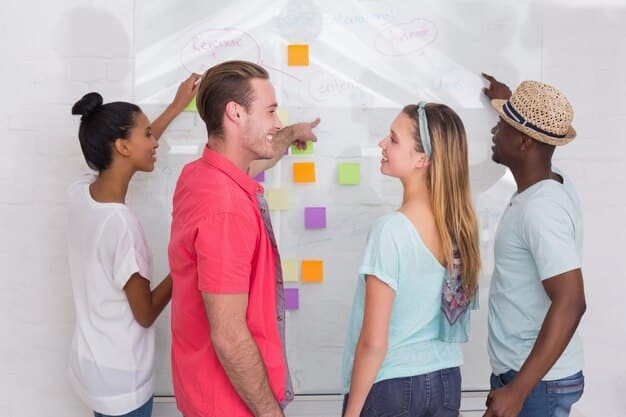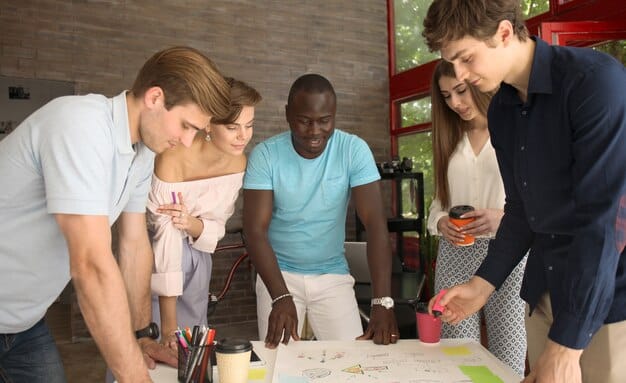Boost Creativity: Design Thinking for New Product Innovation

Applying design thinking principles is a transformative strategy that systematically enhances creativity and fosters the development of innovative products by focusing on user needs, iterative prototyping, and continuous feedback.
In a world increasingly driven by rapid change and evolving consumer demands, the ability to <Boost Your Creativity: Learn Design Thinking Principles to Innovate and Develop New Products> has become not just an advantage, but a necessity. This approach, rooted in empathy and iterative problem-solving, offers a powerful framework for individuals and organizations seeking to unlock new possibilities and create solutions that truly resonate with users.
understanding design thinking: more than just a methodology
Design thinking is frequently categorized as a methodology, a process, or a framework. However, viewing it solely through these lenses might diminish its true essence. It is, at its core, a human-centered approach to innovation that draws from the designer’s toolkit to integrate the needs of people, the possibilities of technology, and the requirements for business success. It’s a mindset that encourages continuous learning, experimentation, and a deep understanding of the problem space before jumping to solutions.
The journey of design thinking typically follows a series of iterative stages, though it’s crucial to understand that these stages are not strictly linear. They often overlap, and teams may loop back to earlier stages as new information or insights emerge. This inherent flexibility is what makes design thinking particularly robust in tackling complex problems where the solution isn’t immediately obvious. It encourages a fluid progression, moving between divergent thinking (generating many ideas) and convergent thinking (narrowing down to the best ideas) throughout the process.
the five core stages
While various interpretations exist, the Stanford d.school’s five-stage model is widely recognized and provides a solid foundation. These stages, while distinct, are interconnected and mutually reinforcing. Skipping a stage or rushing through it can often lead to less impactful outcomes.
- Empathize: This foundational stage involves gaining a deep understanding of the people you are designing for. It requires putting aside assumptions and engaging with users through observation, interviews, and immersion to uncover their needs, motivations, and frustrations.
- Define: Based on the empathy stage, this is where you synthesize your findings into a clear, actionable problem statement. It’s about framing the right challenge, ensuring you’re solving the right problem for your users.
- Ideate: With a well-defined problem, this stage focuses on generating a wide range of potential solutions. Quantity over quality is key here, encouraging creative freedom and deferring judgment to explore diverse ideas.
This iterative cycle allows for continuous refinement and adaptation. Rather than striving for perfection in the first attempt, design thinking advocates for rapid prototyping and testing, making the process more efficient and user-centric. It enables teams to fail fast, learn quickly, and pivot their approach based on real-world feedback, minimizing risk and maximizing the potential for successful innovation.
Ultimately, design thinking cultivates a culture of curiosity and collaboration. It breaks down silos within organizations, bringing together diverse perspectives to collectively address challenges. By embracing ambiguity and prioritizing user needs, design thinking moves beyond traditional linear problem-solving, fostering a more dynamic and responsive approach to innovation.
empathy: the cornerstone of innovative product development
In the expansive landscape of product development, where technological advancements often steal the spotlight, the human element can sometimes be overlooked. However, for genuinely innovative products, empathy is not just a nice-to-have; it’s the fundamental building block. Without a profound understanding of the end-user – their desires, their pain points, their daily struggles – any product, no matter how technologically sophisticated, risks missing its mark. Empathy ensures that solutions are developed for real people, addressing real-world problems in meaningful ways.
Developing empathy isn’t merely about conducting surveys or collecting data. It requires a more immersive, qualitative approach. It involves stepping into the shoes of your users, observing their behaviors in their natural environments, and listening attentively to their stories. This deep immersion helps uncover unarticulated needs – those desires or frustrations that users might not even be aware of themselves, but which, once addressed, can lead to groundbreaking innovations. These hidden insights often reveal opportunities that quantitative data alone cannot.
techniques for cultivating deep user empathy
To move beyond superficial understanding, designers and product developers employ a range of techniques aimed at fostering genuine empathy. These methods help to build a rich, nuanced picture of the user, transforming abstract data points into relatable human experiences. The goal is to move past assumptions and preconceptions, discovering what truly matters to the people who will interact with the product.
- User Interviews: Conduct one-on-one conversations to understand users’ perspectives, experiences, and emotions related to a specific problem or context. Open-ended questions are crucial here to encourage detailed narratives.
- Observation & Ethnography: Watch users as they perform tasks in their natural settings. This can reveal behavioral patterns, workarounds, and environmental factors that users might not articulate in an interview.
- Journey Mapping: Visualize the entire process a user goes through to achieve a goal. This helps identify touchpoints, pain points, and moments of delight, offering a holistic view of their experience.

The insights gathered during the empathy phase serve as the bedrock for the entire product development cycle. They inform the problem definition, inspire ideation, and guide the prototyping and testing phases. Products born from deep empathy are not only more likely to succeed but also tend to create stronger emotional connections with users, fostering loyalty and advocacy. It shifts the focus from what can be built to what truly needs to be built, creating solutions that are both innovative and deeply human-centered.
Empathy is a continuous practice, not a one-time event. As products evolve and user needs shift, maintaining an empathetic connection with the target audience ensures that innovation remains relevant and impactful. It transforms product development from a purely technical exercise into a creative endeavor aimed at enhancing human experience.
defining the problem: framing challenges for innovative solutions
After immersing oneself in the user’s world through empathy, the next critical step in design thinking is to define the problem. This stage is less about finding answers and more about asking the right questions. Without a clearly articulated, user-centered problem statement, teams risk solving the wrong problem, leading to solutions that miss the mark or offer little real value. A well-defined problem acts as a compass, guiding the subsequent ideation and prototyping phases towards meaningful innovation.
The definition phase involves synthesizing the vast amounts of qualitative data collected during empathy research into actionable insights. It’s about identifying patterns, pinpointing key pain points, and articulating the underlying needs that users may not even be aware of themselves. This synthesis helps to move beyond surface-level symptoms to address the root causes of problems. The “point of view” (POV) statement, often used in design thinking, captures this synthesis by framing the problem from the user’s perspective, highlighting their need and the underlying insight.
crafting effective problem statements
A strong problem statement is concise, specific, and customer-centric. It avoids suggesting a specific solution and instead focuses on the user’s need and the context in which that need arises. This open-ended approach encourages broader ideation and prevents teams from prematurely narrowing their focus. It should provoke creative thinking and align the team around a common understanding of the challenge they are trying to address.
- User-Centric Language: Frame the problem from the perspective of the user, using “How Might We” (HMW) questions to invite solutions rather than prescriptive statements. For example, instead of “Design a new app,” consider “How might we help busy parents quickly organize their children’s schedules?”
- Specificity & Scope: While open, the problem statement should not be too broad. It needs enough focus to guide ideation without stifling creativity. Avoid vague terms and ensure it pinpoints a manageable problem.
- Actionable & Testable: An effective problem statement should suggest that a solution can be created and that its impact can be measured. It sets the stage for tangible outcomes and iterative testing.
This iterative nature of defining the problem also means that problem statements can evolve. As new insights emerge during ideation or prototyping, teams might revisit and refine their problem statement to ensure it still accurately reflects the underlying challenge. This continuous refinement ensures that the design process remains grounded in real user needs and adapts to new discoveries.
Ultimately, framing the right challenge is just as crucial as finding the right solution. By investing time and effort in the define phase, teams significantly increase their chances of developing products that are not only innovative but also deeply relevant and valuable to their target users. It ensures that creativity is directed towards solving problems that truly matter.
ideation: unleashing divergent thinking for novel solutions
Once a problem is clearly defined, the next exhilarating stage in the design thinking process is ideation. This is where teams unleash their collective creativity to generate a vast array of potential solutions, without judgment or constraint. Ideation is fundamentally about divergent thinking – producing as many ideas as possible, no matter how unconventional they may seem at first. The quantity of ideas takes precedence over their immediate practicality, as even a seemingly wild idea can spark a truly innovative solution when combined or refined.
The goal of ideation is to explore a broad solution space, challenging assumptions and pushing the boundaries of conventional thinking. It actively discourages self-censorship, encouraging participants to build upon each other’s ideas in a synergistic manner. This collaborative yet unrestrictive environment allows for the surfacing of novel concepts that might otherwise remain hidden. It creates a fertile ground for breakthroughs, moving beyond obvious solutions to truly innovative possibilities.
techniques for fostering productive ideation sessions
To facilitate effective ideation, various techniques are employed, each designed to stimulate different types of creative thinking and ensure a diverse range of ideas. The choice of technique often depends on the specific challenge and the dynamics of the team, but all aim to maximize output and encourage bold contributions. The key is to create an atmosphere where every idea is welcomed, no matter how simple or complex.
- Brainstorming: The classic technique where a group generates ideas spontaneously and without criticism. Rules often include deferring judgment, encouraging wild ideas, building on others’ ideas, and focusing on quantity.
- Mind Mapping: A visual technique that helps organize thoughts and branch out into related concepts. Start with a central idea and expand outwards, connecting themes and potential solutions.
- SCAMPER Method: A checklist of provocative questions used to trigger new ideas by looking at an existing product or problem through different lenses: Substitute, Combine, Adapt, Modify (Magnify/Minify), Put to another use, Eliminate, Reverse/Rearrange.
- Worst Possible Idea: Counter-intuitively, asking participants to generate the absolute worst ideas can break creative blocks and lead to unexpected insights by forcing a re-evaluation of assumptions.
The output of an ideation session is typically a large collection of unrefined ideas. The next step, often still within the ideation phase or transitioning into prototyping, is to select and refine the most promising ideas. This often involves grouping similar ideas, identifying recurring themes, and voting or ranking based on criteria established during the define phase. The most promising ideas are then prepared for the next stage: prototyping.
Ideation is more than just coming up with ideas; it’s about fostering an environment where innovation can flourish. By encouraging diverse perspectives and embracing creative freedom, teams can unlock their full potential to develop truly novel and impactful solutions that address the defined problem from multiple angles.
prototyping: building to learn, iterating to refine
In the iterative world of design thinking, prototyping is the stage where ideas begin to take tangible form. It’s not about creating a polished, faultless product, but rather about building rough, low-fidelity versions of solutions to test assumptions, gather feedback, and learn quickly. Prototyping embodies the principle of “building to learn,” allowing teams to explore concepts cost-effectively before investing significant resources. This stage accelerates the learning cycle, turning abstract ideas into concrete experiences that can be shared and critiqued.
The beauty of prototyping lies in its emphasis on rapid iteration. Teams don’t aim for perfection in the first prototype; instead, they create multiple versions, each incrementally improving based on insights gleaned from previous tests. This continuous cycle of build, test, learn, and refine minimizes risk and ensures that the final product is not only desirable but also feasible and viable. It allows for quick pivots and adjustments, preventing costly missteps down the line. It’s a fundamental shift from a linear development model to a dynamic, discovery-driven process.
approaches to effective prototyping
The choice of prototyping method depends heavily on what needs to be tested and what questions need to be answered. Prototypes can range from simple sketches on paper to interactive digital models, each serving a specific purpose in the learning process. The key is to select the lowest fidelity prototype that is capable of conveying the core idea and eliciting valuable feedback from users or stakeholders.
- Paper Prototypes: Simple sketches or drawings of interfaces or product flows. Ideal for testing basic concepts and user flows very early in the process. Cost-effective and quick to create and modify.
- Clickable Wireframes: Digital prototypes that simulate basic interactions without full visual design. Useful for testing navigation and user journeys in a more interactive way.
- Physical Models: For physical products, simple mock-ups made from cardboard, foam, or LEGOs can help visualize form, function, and user interaction.

During the prototyping stage, feedback is invaluable. Engaging potential users and stakeholders in testing sessions provides critical insights into what works, what doesn’t, and what improvements are needed. This feedback loop is essential, as it directly informs the subsequent iterations of the prototype, bringing the solution closer to meeting genuine user needs. It’s important to approach feedback with an open mind, viewing it as an opportunity for growth and refinement, rather than critique.
Prototyping transforms abstract concepts into tangible experiences, making innovation more concrete and accessible. It empowers teams to test bold ideas, gather real-world data, and iterate their way to truly impactful solutions, ensuring that creativity translates into functional and desirable products.
testing: gathering feedback and iterating for impact
The testing phase in design thinking is not merely the end of the line; it’s another crucial loop in the iterative process. After prototypes have been built, they are placed in front of real users to gather feedback, validate assumptions, and uncover new insights. This stage is vital for understanding how a product or solution performs in a real-world context and whether it truly addresses the user’s needs as defined in earlier stages. Testing reveals what works, what doesn’t, and why, providing concrete data to inform subsequent refinements.
The goal of testing is not to prove that an idea is perfect, but rather to discover its flaws, identify areas for improvement, and validate the core concept. It provides an opportunity for constructive criticism and helps to mitigate risks before significant resources are committed to development. By observing users interact with prototypes and listening to their feedback, teams can gain invaluable perspectives that were not apparent during earlier phases. This direct interaction helps build empathy even further, as designers witness firsthand how their solutions impact users.
strategies for effective user testing
Effective testing requires careful planning and execution to ensure that the feedback gathered is meaningful and actionable. The focus should be on observing user behavior and prompting honest, unfiltered reactions, rather than leading users towards preconceived notions. Setting clear objectives for each testing session helps to keep the feedback focused and relevant to the current stage of the prototype’s development.
- Usability Testing: Observe users performing specific tasks with the prototype to identify pain points, confusions, and areas where the design might be unintuitive. Think-aloud protocols can be particularly insightful.
- A/B Testing: Presenting different versions of a design element (e.g., button color, headline, layout) to different user groups to see which performs better on a specific metric. While often used later in development, it can be adapted for prototype testing.
- Feedback Sessions: Structured conversations where users provide their thoughts, preferences, and criticisms after interacting with the prototype. Open-ended questions are preferred to encourage detailed responses.
The insights derived from testing directly feed back into the design process. If significant issues are uncovered, teams might loop back to the ideation or even the define phases to reframe the problem or generate entirely new solutions. Minor issues may lead to quick tweaks and further testing. This continuous cycle of testing and iteration is what allows design thinking to produce highly refined, user-centered products that truly solve problems effectively.
Testing cultivates a culture of continuous improvement. By embracing feedback and viewing failures as learning opportunities, teams can iteratively refine their solutions, increasing the likelihood of developing truly innovative and impactful products that resonate deeply with their intended users. It is an indispensable stage for translating creative ideas into tangible success.
implementing and iterating: bringing designs to life
The final and equally crucial stage of the design thinking process is implementation, followed by continuous iteration. While often depicted as the end, implementation is more accurately seen as a transition from the design lab to the real world, followed by a persistent cycle of refinement and adaptation. This phase is about bringing the validated solution to full realization, scaling it, and ensuring its long-term viability and impact. It involves the practicalities of engineering, marketing, and distribution, transforming a successful prototype into a functional product or service that reaches its target audience.
However, the journey doesn’t end with a product’s launch. The principles of design thinking, particularly the emphasis on empathy and continuous learning, extend far beyond the initial release. Once a product is in the hands of users, real-world data and feedback begin to pour in. This information is invaluable for identifying new opportunities, addressing unmet needs, and evolving the product to maintain its relevance and competitiveness. This ongoing iteration ensures that innovation remains a dynamic process, not a static achievement.
strategies for successful implementation and ongoing iteration
Successful implementation requires careful planning, effective project management, and cross-functional collaboration. It’s about translating the design vision into a tangible reality while maintaining fidelity to the user insights uncovered earlier. Once launched, a robust framework for collecting and acting on user feedback is essential for sustained success. This feedback loop fuels the iterative improvements that keep the product evolving and thriving.
- Pilot Programs & Phased Rollouts: Launching a product or service to a smaller, controlled group first allows for real-world testing and refinement before a full-scale release, minimizing risks.
- Analytics & User Data Monitoring: Continuously collect and analyze quantitative data on user behavior, engagement, and performance metrics to identify trends, pain points, and areas for optimization.
- Customer Support & Feedback Channels: Establish clear channels for users to provide feedback, report issues, and suggest improvements. This direct input is invaluable for product evolution.
- Regular User Research: Periodically revisit empathy-building techniques (interviews, observations) to understand how user needs and contexts might have changed, informing future product iterations and new feature development.
The implemented solution becomes part of a living ecosystem, constantly interacting with its users and the broader market. Design thinking provides the framework for this continuous evolution. By maintaining an empathetic stance, defining new problems as they arise, iterating on existing features, and prototyping new solutions, organizations can ensure their products remain aligned with user needs and market demands, fostering sustained innovation. The final stage is, in essence, a recommencement of the entire design thinking cycle, ensuring that creativity is a constant process.
Ultimately, design thinking doesn’t just create products; it fosters a culture of innovation that thrives on continuous learning and adaptation. By embracing implementation as a springboard for further evolution, organizations are poised for long-term success in an ever-changing landscape.
| Key Principle | Brief Description |
|---|---|
| 💖 Empathy-Driven | Focuses on understanding user needs deeply through observation and interaction. |
| 💡 Iterative Ideation | Generates many ideas, then refines them through cycles of testing and feedback. |
| 🛠️ Prototyping | Builds simple models to test concepts quickly and cost-effectively, learning by doing. |
| 🔄 Continuous Testing | Engages users to gather real-world feedback, informing ongoing product development. |
frequently asked questions about design thinking
The core idea of design thinking is a human-centered approach to innovation, focusing on deep empathy for users, iterative problem-solving, and hands-on experimentation. It seeks to understand user needs, challenge assumptions, redefine problems, and create innovative solutions through a systematic yet flexible process, driven by user feedback and continuous learning.
Design thinking boosts creativity by encouraging divergent thinking in the ideation phase, where quantity of ideas matters more than quality initially. It promotes an iterative cycle of empathizing, defining, ideating, prototyping, and testing, which fosters experimentation and learning from failure. This structured approach, combined with a focus on user needs, helps unlock novel and relevant solutions.
While often associated with product development, design thinking is a versatile framework applicable to a wide range of challenges. It can be used for developing services, improving processes, designing customer experiences, or even addressing organizational and social issues. Its emphasis on empathy and structured problem-solving makes it valuable in any context requiring innovative solutions for human needs.
Empathy is the foundational stage of design thinking. It involves deeply understanding the target users’ needs, motivations, and pain points by observing, engaging with, and immersing oneself in their experiences. This profound understanding ensures that the problems identified and the solutions developed are genuinely relevant and valuable to the people for whom they are designed, preventing misdirected efforts and fostering true innovation.
Prototyping and testing are crucial for design thinking. Prototyping involves building rough versions of ideas to explore concepts and gather feedback efficiently, while testing puts these prototypes in front of real users to validate assumptions and uncover practical insights. This iterative cycle allows teams to learn quickly, refine solutions based on real-world data, and mitigate risks before significant investments are made, ensuring a user-centric and effective outcome.
conclusion
In essence, design thinking offers more than just a set of steps; it provides a transformative mindset for innovation. By placing empathy at its core and embracing an iterative cycle of defining, ideating, prototyping, and testing, individuals and organizations can systematically address complex challenges and create truly impactful solutions. This human-centered approach not only fuels creativity but also ensures that developed products and services genuinely resonate with user needs, paving the way for sustained success in an ever-evolving landscape. Adopting these principles equips you to not just solve problems, but to innovate with purpose and precision.





